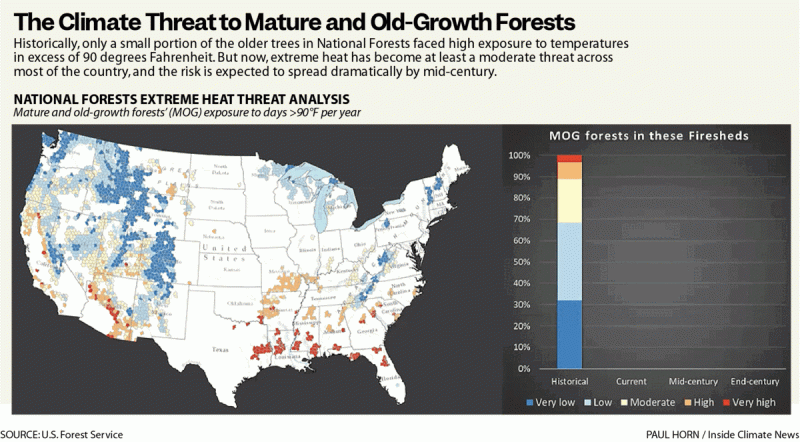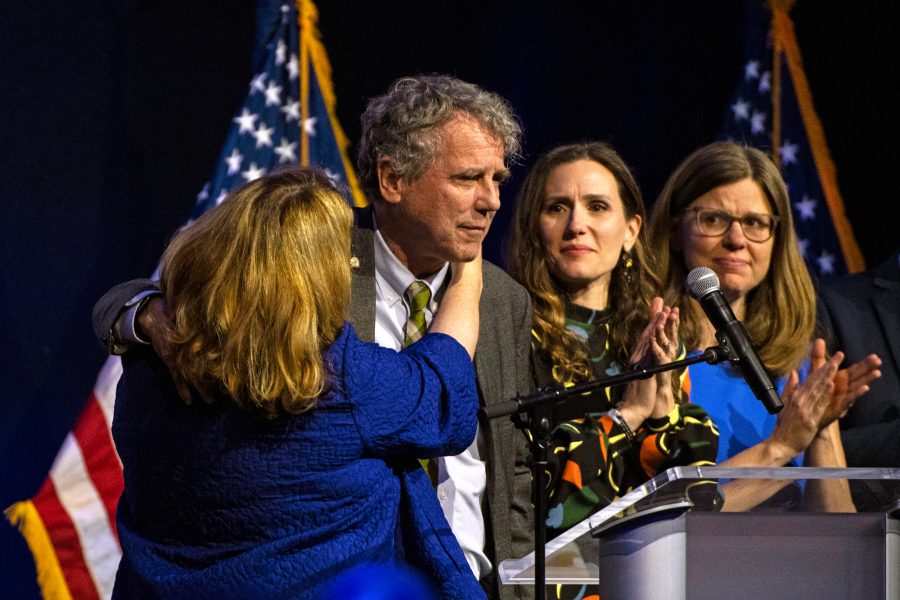Biden Administration Takes Historic Step to Protect Old-Growth Forest
In an unprecedented step to preserve and maintain the most carbon-rich elements of U.S. forests in an era of climate change, President Joe Biden’s administration last week proposed to end commercially driven logging of old-growth trees in National Forests.
Secretary of Agriculture Tom Vilsack, who oversees the U.S. Forest Service, issued a Notice of Intent to amend the land management plans of all 128 National Forests to prioritize old-growth conservation and recognize the oldest trees’ unique role in carbon storage.
It would be the first nationwide amendment to forest plans in the 118-year history of the Forest Service, where local rangers typically have the final word on how to balance forests’ role in watershed, wildlife and recreation with the agency’s mandate to maintain a “sustained yield” of timber.
“Old-growth forests are a vital part of our ecosystems and a special cultural resource,” Vilsack said in a statement accompanying the notice. “This clear direction will help our old-growth forests thrive across our shared landscape.”
But initial responses from both environmentalists and the logging industry suggest that the plan does not resolve the conflict between the Forest Service’s traditional role of administering the “products and services” of public lands—especially timber—and the challenges the agency now faces due to climate change. National Forests hold most of the nation’s mature and old-growth trees, and therefore, its greatest stores of forest carbon, but that resource is under growing pressure from wildfire, insects, disease and other impacts of warming.
Views could not be more polarized on how the National Forests should be managed in light of the growing risks.
National and local environmental advocates have been urging the Biden administration to adopt a new policy emphasizing preservation in National Forests, treating them as a strategic reserve of carbon. Although they praised the old-growth proposal as an “historic” step, they want to see protection extended to “mature” forests, those dominated by trees roughly 80 to 150 years old, which are a far larger portion of the National Forests. As old-growth trees are lost, which can happen rapidly due to megafires and other assaults, they argue that the Forest Service should be ensuring there are fully developed trees on the landscape to take their place.
On the other hand, timber companies argue that they provide the solutions to the pressures that the National Forests face in a warming world. By thinning out overstocked forests, they say they can help reduce wildfire risk and make the forests more climate resilient. They say that instead of forcing National Forest managers to consider and incorporate a new national mandate, local rangers should be giving their full focus to hazardous fuels reduction and “treatments”—including thinning and logging—to improve forest health.
The Biden administration’s new proposal seeks to take a middle ground, establishing protection for the oldest trees under its stewardship while allowing exceptions to reduce fuel hazards, protect public health and safety and other purposes. And the Forest Service is seeking public comment through Feb. 2 on the proposal as well as other steps needed to manage its lands to retain mature and old-growth forests over time, particularly in light of climate change.
The National Climate Assessment released by the administration this fall included data underscoring the urgency of the issue: The amount of carbon sequestered by U.S. forest land decreased by 22 percent from 1990 to 2019 (from 816 to 638 million tons of carbon dioxide) due to a combination of drought, wildfire and disturbances by insects and disease. In webcast presentations this fall on its work to update agency policy, the Forest Service showed that the amount of mature and old-growth forest in National Forests exposed to temperatures in excess of 90 degrees for more than two months a year has doubled compared to the last three decades of the last century. If global carbon emissions continue on a high trajectory, exposure to such extreme temperatures is on track to double again by mid-century and double again by the end of the 21st century.
“Climate change isn’t knocking at the door,” said Forest Service wildlife biologist Raymond Davis. “It’s got a foot inside the house already.”
Disputed Views on Oregon’s 2020 Fires
Probably no event better illustrates the opposing views on the future of the National Forests than the megafires that ignited over Labor Day weekend 2020 in Oregon, burning 1 million acres across the state—twice its 10-year average. Three separate fires roared across 176,000 acres of Willamette National Forest, destroying both mature and old-growth forest, including critical habitat for the endangered Northern Spotted Owl. Fire temperatures were so intense that the organic layer of the soil was lost in places, complicating the job of replanting and recovery.
Timber industry groups argue that the destruction undercuts one of the arguments of forest preservationists—that mature and old-growth trees are the most resistant trees to wildfire, and therefore, maintaining them will not increase wildfire risk.
“Go out and look at the Holiday Farm Fire in western Oregon and tell us that large old trees are resilient to wildfire,” said Travis Joseph, president and CEO of the American Forest Resource Council, in an interview earlier this year. “You have massive trees that are burned up and dead because of the forest conditions,” said Joseph, whose group represents Western timber companies.
“Our view is clean up the forest, thin it out, make it more resilient,” he said, adding that prescribed fire as well as thinning was needed. “And of course, it makes sense through proactive science-based management to be protecting those bigger, older trees. But right now, those older, bigger trees are getting burned up, and we’re losing them—not because of logging.”
But in a study of the Oregon fires published in 2022, Forest Service scientists concluded that no amount of thinning could have prevented the destruction given the intensity of the fires that engulfed the forest. They found that forest stands burned at high severity regardless of whether they had low or high levels of biomass. Moreover, they found evidence in paleoecological records that infrequent high-severity fires are a pattern in the mountainous ranges of the Pacific Northwest, occurring when late summer drought is followed by strong east-west winds. Both dryness and winds were extreme in September 2020.
“Our findings reinforce that the Labor Day fires were fundamentally a weather-driven event,” the Forest Service scientists wrote. “The influence of forest management on fire severity was minimal and variation in forest structure or fuels played relatively little role.”
Lending support to that conclusion is the fact, disclosed in public reports to shareholders, that private forests managed for timber production, like those belonging to forest giant Weyerhaeuser, also sustained major losses in the 2020 Oregon fires, as did the reserves within Willamette National Forest where logging was restricted to preserve old-growth and the habitat of the spotted owl.
Environmentalists say the Oregon fires underscore why, in addition to taking important steps for nationwide protection of old-growth, they want to see the Forest Service extend protection to mature forests.
“These old-growth trees will eventually die, just like all living things on the planet,” said Randi Spivak, director of the public lands program for the Center for Biological Diversity. “These forests cannot do their important jobs of pulling carbon from the air, and protecting biodiversity and watersheds, if we don’t restore the amount of old-growth across the landscape, and that is mature forest. They are our future old growth.”

If the Forest Service were to put in place nationwide protections for both mature and old-growth forests, it would close off most of the National Forests to logging. In an inventory concluded earlier this year in response to a Biden executive order, the Forest Service found that 24.7 million acres, or 17 percent, of its 144.3 million acres of forest are old-growth, while 68.1 million acres, or 47 percent, are mature.
Congress Offers Money, But Little Direction
Like all federal agencies, the Forest Service is grappling with climate change with little direction from Congress. The agency’s primary governing statutes, which date back to 1960 and 1976, did not contemplate climate change. Although the 1976 National Forest Management Act put a greater emphasis on environmental protection than the earlier timber harvest-focused law, the agency’s mandate remained to manage National Forests “under principles of multiple use and to produce a sustained yield of products and services.”
Congress never told the Forest Service which of the multiple uses—timber, water and wildlife, recreation—should take priority, leaving decision-making to local managers based on local needs and conditions. In more recent years, as wildfire risk and forest health have become more pressing problems, Congress has allocated money and authorized the Forest Service to enter into agreements with outside groups for assistance. In some cases, critics have argued those outside contracts have helped perpetuate logging projects.
Before last week’s announcement by Vilsack, a coalition of more than 120 national and local environmental groups, the Climate Forests Campaign, had identified at least 20 logging projects planned or underway that target 370,000 acres of mature and old-growth trees in National Forests. Local rangers have a range of reasons for these projects, not only wildfire risk reduction, but restoration of certain species, like oak, as well as creation of “young” forest. Money that Congress has allocated to the Forest Service for “hazardous fuels reduction” in spending bills like the 2021 bipartisan Infrastructure Investment and Jobs Act shows that lawmakers want these logging projects to take place, in the view of timber industry advocates.
“Congress has made it clear that job one is reducing the threat of catastrophic fires by thinning our National Forests, something our industry is more than capable of doing,” said Bill Imbergamo, executive director of the Federal Forest Resource Coalition. “Instead, the same staff who should be planning fuels treatments are going to be engaged in a rushed, top-down effort to amend every forest plan to restrict management options on even more acres of National Forests.”
But not all members of Congress interpret the laws that way. In a letter to the lands management agencies, a group of Democratic members from Oregon, including both of the state’s senators, said the infrastructure law’s intent was to enhance protection of mature and old-growth forests as well as reduce hazardous fuels.
“Oregonians know all too well the impact of the climate crisis on our forests that are held dear as places of work as well as places of refuge,” Oregon Senator Ron Wyden said in an email. “They’ve feared for their health and safety as bigger and more intense wildfires have hit our state, watched entire towns leveled to ash and choked on harmful wildfire smoke. As ecosystems adapt to climate change, so too must forest management.”
But how should forest management change?
Wyden said, in his email, that active management and conservation “need not be mutually exclusive,” and that they should be guided by science as well as Indigenous knowledge. (Vilsack’s new policy includes a provision to “more clearly recognize and incorporate Indigenous knowledge and tribal rights and interests in managing for old-growth forest conditions.”)
Some argue that National Forests should play a large role in meeting Biden’s goal, set out in his first week in office, of conserving at least 30 percent of U.S. lands by 2030 as part of the nation’s plan to mitigate climate change. A 2021 analysis by the nonprofit think tank Resources for the Future showed that only 14.2 percent of U.S. land could be categorized as protected. But the U.S. could meet the 30 percent goal immediately if all extractive lands held by the Forest Service and the Bureau of Land Management (which manages some forests as well as rangeland used for grazing and energy development) were given protected status.
Since then, the Biden administration has instituted new protections in special areas—for example, in the world’s largest intact temperate rainforest in Tongass National Forest in Alaska—but the Forest Service is still grappling with how to address both climate resilience and mature and old-growth forest protection on the majority of the lands it manages.
The agency sees the biggest threats to older trees as wildfire, which has consumed 2.6 million acres of mature and 689,000 acres of old growth forest on public lands since 2000, and insects and disease, which have destroyed 1.9 million acres of mature and 134,000 acres of old growth in that time. In contrast, logging on public lands—much reduced since the peak years of the 1970s and 1980s—has removed 244,500 acres of mature forest and 9,300 acres of old-growth.
And the agency, which still evaluates performance based in part on timber targets, made clear it sees logging as integral to climate resilience in its webcast presentation this fall. It included among the threats to mature and old-growth forests a “lack of mill capacity” in some areas. In other words, the agency’s view is that it can’t properly maintain forests without facilities to process chopped down trees.
“Are they looking at the chainsaw as their only tool?” asked Blaine Miller-McFeeley, a senior lobbyist for Earthjustice, which has taken the Forest Service to court over logging plans. “That’s taking a pretty narrow and potentially predetermined view of what the solutions are for addressing threats.”
Greg Aplet, senior scientist for The Wilderness Society, believes the main barrier to change in Forest Service practices is cultural, in that the agency has prided itself in its roles in providing wood for society and protecting citizens from wildfire. Over time, prodded by policies like endangered species protection, the Forest Service has set aside protected areas. But Aplet argues that’s not enough, given the challenges of climate change.
“The old paradigm that has governed the National Forest System since its founding is the purpose of the National Forests is to produce timber,” Aplet said. “And if you want to do anything other than that, you better designate it for some other use, like wilderness or roadless areas, or old growth reserves. And what you don’t designate, you manage for timber.”
But events in the National Forests over at least the past decade have shown that climate change doesn’t recognize such designations. “We can’t assign anything to a particular state forever, and expect it to stay that way,” Aplet said. “The system is just too dynamic.”
Share this article
Disclaimer: The copyright of this article belongs to the original author. Reposting this article is solely for the purpose of information dissemination and does not constitute any investment advice. If there is any infringement, please contact us immediately. We will make corrections or deletions as necessary. Thank you.







